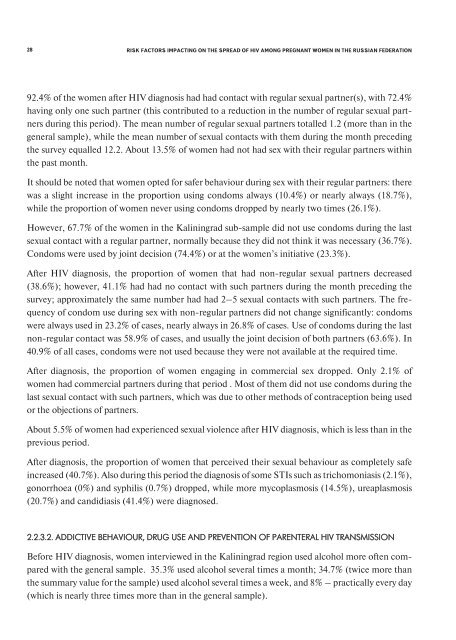risk factors impacting on the spread of hiv among pregnant women ...
risk factors impacting on the spread of hiv among pregnant women ...
risk factors impacting on the spread of hiv among pregnant women ...
You also want an ePaper? Increase the reach of your titles
YUMPU automatically turns print PDFs into web optimized ePapers that Google loves.
28<br />
RISK FACTORS IMPACTING ON THE SPREAD OF HIV AMONG PREGNANT WOMEN IN THE RUSSIAN FEDERATION<br />
92.4% <strong>of</strong> <strong>the</strong> <strong>women</strong> after HIV diagnosis had had c<strong>on</strong>tact with regular sexual partner(s), with 72.4%<br />
having <strong>on</strong>ly <strong>on</strong>e such partner (this c<strong>on</strong>tributed to a reducti<strong>on</strong> in <strong>the</strong> number <strong>of</strong> regular sexual partners<br />
during this period). The mean number <strong>of</strong> regular sexual partners totalled 1.2 (more than in <strong>the</strong><br />
general sample), while <strong>the</strong> mean number <strong>of</strong> sexual c<strong>on</strong>tacts with <strong>the</strong>m during <strong>the</strong> m<strong>on</strong>th preceding<br />
<strong>the</strong> survey equalled 12.2. About 13.5% <strong>of</strong> <strong>women</strong> had not had sex with <strong>the</strong>ir regular partners within<br />
<strong>the</strong> past m<strong>on</strong>th.<br />
It should be noted that <strong>women</strong> opted for safer behaviour during sex with <strong>the</strong>ir regular partners: <strong>the</strong>re<br />
was a slight increase in <strong>the</strong> proporti<strong>on</strong> using c<strong>on</strong>doms always (10.4%) or nearly always (18.7%),<br />
while <strong>the</strong> proporti<strong>on</strong> <strong>of</strong> <strong>women</strong> never using c<strong>on</strong>doms dropped by nearly two times (26.1%).<br />
However, 67.7% <strong>of</strong> <strong>the</strong> <strong>women</strong> in <strong>the</strong> Kaliningrad sub-sample did not use c<strong>on</strong>doms during <strong>the</strong> last<br />
sexual c<strong>on</strong>tact with a regular partner, normally because <strong>the</strong>y did not think it was necessary (36.7%).<br />
C<strong>on</strong>doms were used by joint decisi<strong>on</strong> (74.4%) or at <strong>the</strong> <strong>women</strong>’s initiative (23.3%).<br />
After HIV diagnosis, <strong>the</strong> proporti<strong>on</strong> <strong>of</strong> <strong>women</strong> that had n<strong>on</strong>-regular sexual partners decreased<br />
(38.6%); however, 41.1% had had no c<strong>on</strong>tact with such partners during <strong>the</strong> m<strong>on</strong>th preceding <strong>the</strong><br />
survey; approximately <strong>the</strong> same number had had 2–5 sexual c<strong>on</strong>tacts with such partners. The frequency<br />
<strong>of</strong> c<strong>on</strong>dom use during sex with n<strong>on</strong>-regular partners did not change significantly: c<strong>on</strong>doms<br />
were always used in 23.2% <strong>of</strong> cases, nearly always in 26.8% <strong>of</strong> cases. Use <strong>of</strong> c<strong>on</strong>doms during <strong>the</strong> last<br />
n<strong>on</strong>-regular c<strong>on</strong>tact was 58.9% <strong>of</strong> cases, and usually <strong>the</strong> joint decisi<strong>on</strong> <strong>of</strong> both partners (63.6%). In<br />
40.9% <strong>of</strong> all cases, c<strong>on</strong>doms were not used because <strong>the</strong>y were not available at <strong>the</strong> required time.<br />
After diagnosis, <strong>the</strong> proporti<strong>on</strong> <strong>of</strong> <strong>women</strong> engaging in commercial sex dropped. Only 2.1% <strong>of</strong><br />
<strong>women</strong> had commercial partners during that period . Most <strong>of</strong> <strong>the</strong>m did not use c<strong>on</strong>doms during <strong>the</strong><br />
last sexual c<strong>on</strong>tact with such partners, which was due to o<strong>the</strong>r methods <strong>of</strong> c<strong>on</strong>tracepti<strong>on</strong> being used<br />
or <strong>the</strong> objecti<strong>on</strong>s <strong>of</strong> partners.<br />
About 5.5% <strong>of</strong> <strong>women</strong> had experienced sexual violence after HIV diagnosis, which is less than in <strong>the</strong><br />
previous period.<br />
After diagnosis, <strong>the</strong> proporti<strong>on</strong> <strong>of</strong> <strong>women</strong> that perceived <strong>the</strong>ir sexual behaviour as completely safe<br />
increased (40.7%). Also during this period <strong>the</strong> diagnosis <strong>of</strong> some STIs such as trichom<strong>on</strong>iasis (2.1%),<br />
g<strong>on</strong>orrhoea (0%) and syphilis (0.7%) dropped, while more mycoplasmosis (14.5%), ureaplasmosis<br />
(20.7%) and candidiasis (41.4%) were diagnosed.<br />
2.2.3.2. ADDICTIVE BEHAVIOUR, DRUG USE AND PREVENTION OF PARENTERAL HIV TRANSMISSION<br />
Before HIV diagnosis, <strong>women</strong> interviewed in <strong>the</strong> Kaliningrad regi<strong>on</strong> used alcohol more <strong>of</strong>ten compared<br />
with <strong>the</strong> general sample. 35.3% used alcohol several times a m<strong>on</strong>th; 34.7% (twice more than<br />
<strong>the</strong> summary value for <strong>the</strong> sample) used alcohol several times a week, and 8% – practically every day<br />
(which is nearly three times more than in <strong>the</strong> general sample).
















